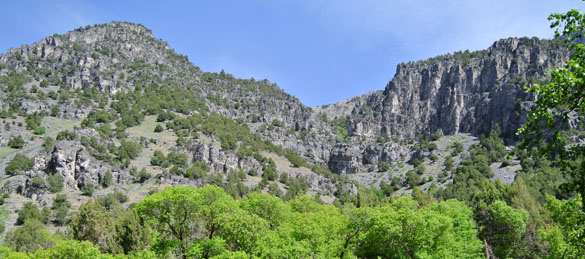LOGAN, UTAH–Today we hiked up part of Logan Canyon along the south side of the Logan River. Towering above us on either side were massive limestone cliffs, as shown above. The thickest unit is the Lodgepole Limestone Formation (Lower Carboniferous, Tournaisian — about 350 million years old), which is well known throughout the northern Rocky Mountains. I’ve long admired its extent and consistency. It testifies to a shallow carbonate platform that extended from what is now Utah, and Colorado up into central Montana. In fact, correlative carbonates by other names are found from Arizona (the Redwall Limetone) well into Canada. I’ve also been impressed with those many paleontologists over the past century and a half who have managed to pry fossils out of its concrete-like matrix. When they do they have beautiful bryozoans, brachiopods and rugose corals. Some of the best are silicified and removed by dissolving the calcitic matrix from around them.

View of the northern side of Logan Canyon, Utah. The Lodgepole Limestone Formation makes up the major cliff on the right.
The Lodgepole Limestone Formation is part of the Madison Group of mostly limestones and dolomites. Most of these rocks are affected by karstic weathering, so the terrain often has disappearing streams, sinkholes and caverns.
While the carbonates of the Lower Carboniferous were being deposited in western North America, mixed siliciclastics dominated the east. Last semester’s Sedimentology & Stratigraphy class studied some of those rocks on their field trip to Lodi and the southern edge of Wooster, Ohio. It is always fascinating to look at very different sediments deposited at the same time in different places.



